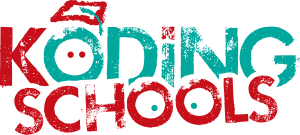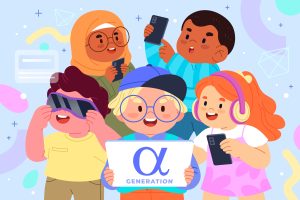Digital is everywhere: at school, at work, in everyday life. Yet, very few children are taught how to code from an early age. At Koding Schools, even though coding is just one of five pillars in our digital education approach, we strongly believe it is an essential skill for every student’s future. That’s why it represents 50% of class time in our curriculum.
Here’s why (with solid research to back it up!):
- At what age can children start coding?
No need to wait until high school! Studies show that children can begin learning the basics of coding as early as 6 or 7 years old, using age-appropriate activities. Early exposure to algorithmic thinking is not only possible, but highly beneficial (Bers, 2020¹).
- Coding enhances logic and math skills
Learning to code means learning how to think. Coding teaches students to break down problems into precise steps and apply mathematical concepts in fun, practical contexts.
The result? Improved understanding of math and more structured thinking across all subjects (OECD, 2021²; Grover & Pea, 2023³).
- Confidence and perseverance through creation
Writing a working program brings a powerful sense of accomplishment. Research shows that this kind of success boosts students’ motivation, self-confidence, and perseverance, helping them tackle academic challenges with resilience (Sullivan & Bers, 2021⁴).
- Coding is a creative outlet
Contrary to popular belief, coding isn’t just for “geeks”! Creating a video game, programming a robot, or building interactive stories helps children develop exceptional creativity. According to MIT, coding clearly fosters personal expression, just like music or drawing (Resnick, 2017⁵).
- Key skills for future careers and entrepreneurship
The job market is evolving fast—and so is the demand for digital skills. The OECD highlights that programming is now one of the most sought-after skills among employers (OECD, 2023⁶). Coding also nurtures an entrepreneurial mindset, encouraging autonomy, initiative, and innovation (National Research Council, 2019⁷).
The World Economic Forum estimates that 85% of the jobs of tomorrow don’t exist yet (WEF, 2020⁹). Teaching children how to code now gives them a critical ability: to adapt quickly and continue learning in an ever-changing world.
- Equal opportunity and closing the gender gap
UNESCO emphasizes the importance of early programming education to fight stereotypes and promote gender equality. Introducing both girls and boys to tech from an early age helps reduce the current gender gap in STEM fields (UNESCO, 2022⁸).
How does Koding Schools integrate programming in your school?
At Koding Schools, we make learning to code accessible, practical, and fun.
We use the PRIMM methodology (Predict, Run, Investigate, Modify, Make), allowing students to build skills step by step:
- First, they observe how code works, then explore it in depth before building their own programs. This structured, gradual approach helps ensure true understanding (Sentance & Waite, 2017¹⁰). We also use unplugged activities, real-life examples, and interactive tools to keep learning engaging.
- Next, students practice each concept visually using a block-based programming approach. By assembling code blocks, they focus on logic and structure without being overwhelmed by syntax or open environments like Scratch.
- Finally, projects at Koding Schools are designed to let students apply what they’ve learned through a wide variety of topics:. animation, games , electronics, robotics even artificial intelligence. They get to explore everything that can be programmed, nurturing their curiosity and love of learning.
Want to bring innovative teaching methods into your school’s curriculum with ease?
Although 100% digital, Koding Schools can be easily included in school supplies with no extra cost for schools!
Contact us for more information!
Interested in our extracurricular program? (clubs, independent teachers, after-school activities…)
Fill out the form to be the first to hear about it and join our early community!








